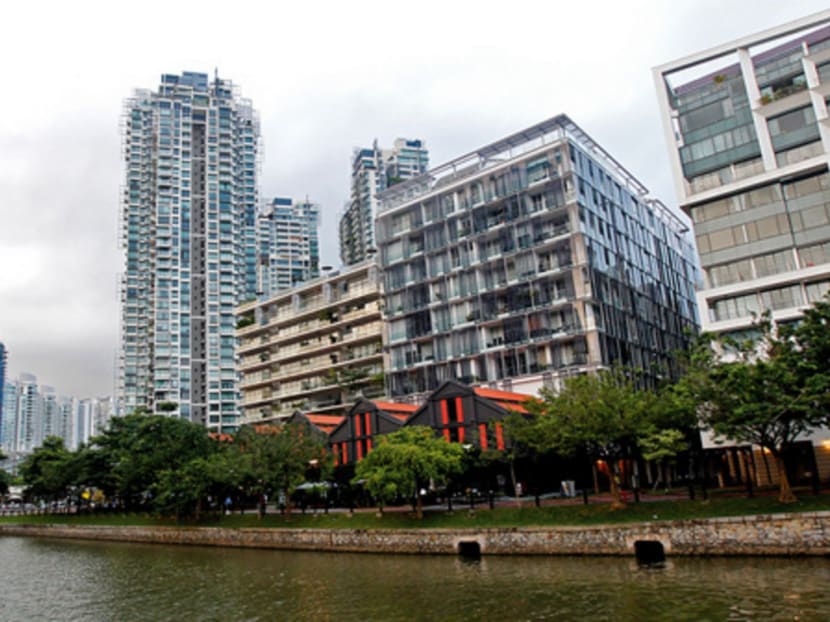Prices of leasehold non-landed homes more resilient than freehold properties: Study
SINGAPORE — Amid the sluggish property market in recent years, prices of leasehold private homes appear to have been more resilient than those which are freehold, according to a study by consultancy Cushman & Wakefield.

A view of private homes in Singapore. TODAY file photo
SINGAPORE — Amid the sluggish property market in recent years, prices of leasehold private homes appear to have been more resilient than those which are freehold, according to a study by consultancy Cushman & Wakefield.
Cushman & Wakefield said prices of non-landed freehold homes saw a steeper drop of over 4 per cent since the third quarter of 2013, compared to the 1 per cent decline for those on a 99-year leasehold. Its study was based on the price indices of freehold and leasehold condominiums compiled by the Urban Redevelopment Authority (URA).
However, analysts have said transaction volumes have been thin, and that could have affected the overall numbers.
Cushman & Wakefield said the weighted average price of leasehold properties have held up better - declining by about 1.4 per cent since the third quarter of 2013. And when compared to the second quarter of 2009 - when the market was at a bottom - they have climbed about 57 per cent.
The consultancy also said that the price gap between the two segments has narrowed.
Ms Christine Li, director of research at Cushman & Wakefield, noted: “If you look at Newton 18, which is a freehold property as compared to its neighbour Amaryllis Ville, (which has a) 99-year lease - if you compared the price gap in the early days, say 2002-2003, the difference is actually about 35 per cent or so. But in recent quarters, the gap has narrowed to 15 per cent, which means that over time, leasehold projects might outperform freehold projects.
“In terms of outlook, if everything is status quo, if the Government does not loosen the cooling measures, TDSR (Total Debt Servicing Ratio) or stringent requirement for en bloc sales, we think leasehold properties could outperform freehold properties, given that attributes of some leasehold properties are better in terms of location and amenities.”
In recent years, curbs on loans, such as the Total Debt Servicing Ratio framework, have weighed on overall property demand, but Cushman & Wakefield said freehold projects are at a disadvantage because they are generally more expensive and require a higher capital outlay.
Analysts said the price performance of freehold and leasehold properties also depends on the en bloc potential. Typically, freehold properties enjoy a higher price premium when the en bloc market is active.
And according to other industry watchers, freehold properties continue to attract interest. Based on a study of caveats lodged, consultancy Knight Frank said the price gap between freehold and leasehold non-landed homes across Singapore has risen - from about 33 per cent in 2011 to nearly 47 per cent last year.
According to numbers from Knight Frank, the yearly prices of freehold units averaged at S$1,532 per square foot (psf) in 2014 - an increase of 9.8 per cent year-on-year. However, those for leasehold units fell by 0.4 per cent over the same period to S$1,045 psf.
Meanwhile, the yearly average price of leasehold developments fell marginally by 0.4 per cent on-year to S$1,045 psf over the same period.
Ms Alice Tan, head of consultancy and research at Knight Frank, said: “Going forward, in the next few years, as the Government gradually releases land sites which are all leasehold tenure, the availability of freehold properties is slated to remain stagnant or decline. Given that limited supply, I think buyers will still have freehold properties as their first choice.”
Meanwhile, Mr Alan Cheong, senior director of research and consultancy at Savills, added: “Look at the resale and subsale market. If you look at the period in time, the gap has been consistently between 25 and 28 per cent since the advent of TDSR. I guess if these measures are in place, the gap would be probably maintaining at the 20-plus per cent range. I do not expect it to come down.”
Analysts said it is important to note that transaction volumes in the last two years have been thin and could affect the overall data analysis. They also noted that apart from land tenure, other factors like location and features of the development, also have an impact on home prices. CHANNEL NEWSASIA





